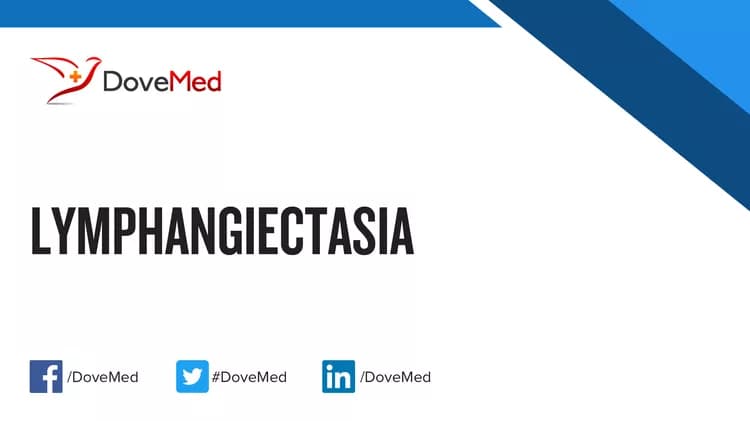What are the other Names for this Condition? (Also known as/Synonyms)
- Abnormally-Dilated Lymphatic Vessels
- Lymphangiectases
What is Lymphangiectasia? (Definition/Background Information)
- The lymph vessels carry lymph in the body. Lymph results from filtration of blood, as it travels to and from the tissues. It is a colorless because it lacks red blood cells; instead, it contains lymphocytes. It is central to the immune system. Lymphocytes are the main white blood cells found in the lymph, which is the fluid of the lymphatic system
- Lymphangiectasia is referred to as an abnormal dilatation of the lymphatic blood vessels. The condition may be congenital or acquired. Congenital Lymphangiectasia may be associated with genetic disorders and acquired Lymphangiectasia may take place secondary to cancer therapy or injury to the lymphatic vessels
- Lymphangiectasia can affect any part of the body. It can affect localized areas of the body, or it may appear diffused (widespread across the body)
- Generally, skin involvement is not uncommon. In such cases, it appears as a vesicle on the skin. It can ooze clear-to-milky fluid if damaged and can be painful. This may result in secondary bacterial infections
- The signs and symptoms and complications of Lymphangiectasia depend upon a variety of factors, including whether its congenital or acquired, and whether it is localized or diffused
- The treatment depends upon the type of Lymphangiectasia. Generally, not all individuals may need treatment. It is also easier to treat localized type of Lymphangiectasia than the generalized type
- The treatment of the condition may involve surgery, laser therapy, and cryotherapy for the skin lesions, to symptomatic and systemic treatment depending on the sites involved. The prognosis of Lymphangiectasia is based on several factors and is normally evaluated on a case-by-case basis
Who gets Lymphangiectasia? (Age and Sex Distribution)
- In general, Lymphangiectasia is a rare disorder that may be seen in a wide age category of children and adults
- Congenital Lymphangiectasia may be manifested at birth, while acquired Lymphangiectasia may develop at any age
- Both males and females are affected and no gender preference is generally observed
- All racial and ethnic groups may be affected and no predilection is seen
What are the Risk Factors for Lymphangiectasia? (Predisposing Factors)
The risk factors for Lymphangiectasia may include the following:
- Congenital forms mainly occur due to abnormal lymphatic system formation during fetal development
- Acquired forms may occur due to certain cancers (including cancer therapy), injury to the lymphatic vessels resulting in drainage obstruction, etc.
It is important to note that having a risk factor does not mean that one will get the condition. A risk factor increases ones chances of getting a condition compared to an individual without the risk factors. Some risk factors are more important than others.
Also, not having a risk factor does not mean that an individual will not get the condition. It is always important to discuss the effect of risk factors with your healthcare provider.
What are the Causes of Lymphangiectasia? (Etiology)
Lymphangiectasia is a disorder wherein the lymphatic vessels are enlarged or dilated. It can be of two types - primary or secondary.
- Primary Lymphangiectasia, also known as congenital Lymphangiectasia, is present from birth. It is caused by an abnormal formation of lymphatic vessels, during fetal growth and development
- Secondary Lymphangiectasia, also known as acquired Lymphangiectasia, may occur due to injury or blockage of the lymphatic vessels from various reasons (cancers, certain heart conditions, etc.)
What are the Signs and Symptoms of Lymphangiectasia?
The signs and symptoms of Lymphangiectasia depend upon whether it is congenital or acquired, if it is diffused or localized, and location of the condition. Both congenital and acquired Lymphangiectasia can have overlapping signs and symptoms, while some may be specific to either the acquired type or congenital type.
The overlapping signs and symptoms, present in both congenital and acquired Lymphangiectasia include:
- The presence of skin lesions that may be fluid-filled or bright red in appearance
- When subjected to minor trauma, the tiny skin papules tend to bleed or ooze a clear or milky fluid; the skin condition can be painful
Signs and symptoms of congenital Lymphangiectasia may include:
- Chronic diarrhea that can result in weight loss
- Associated bone lesions
- Pleural effusion
- Ascites (fluid buildup in the abdominal cavity)
- Soft tissue edema; in some cases, generalized edema all over the body may be observed (trunk and limbs)
- The sites involved may include the lungs and mediastinum (chest/thoracic cavity), intestine, liver and spleen, etc.
Signs and symptoms of acquired Lymphangiectasia may include:
- Thickening of skin due to lymph accumulation
- The surgical sites (usually of lymph node removal) may be affected by Lymphangiectasia, which may include the arms or armpits and legs or groin region
- Lymphangiectasia can occur in the region where cancer is present
How is Lymphangiectasia Diagnosed?
The diagnosis is based upon the type (acquired or congenital) and if Lymphangiectasia is localized or diffused. A diagnosis may involve the following tests and exams:
- A thorough physical exam with evaluation of complete family medical history
- Blood tests
- Radiological imaging studies of the affected region to study the dilated lymphatic vessels
- Genetic tests and analysis to confirm certain congenital forms of Lymphangiectasia
- Angiographic studies such as lymphangiograms of the affected regions
- Upper GI endoscopy for individuals with gastrointestinal symptoms
- Tissue biopsy of the affected region: A tissue biopsy is performed and sent to a laboratory for a pathological examination. The pathologist examines the biopsy under a microscope. After putting together clinical findings, special studies on tissues (if needed) and with microscope findings, the pathologist arrives at a definitive diagnosis
Many clinical conditions may have similar signs and symptoms. Your healthcare provider may perform additional tests to rule out other clinical conditions to arrive at a definitive diagnosis.
What are the possible Complications of Lymphangiectasia?
The complications due to Lymphangiectasia depend upon the location of the disorder, the organs involved, and if the condition is specific to a location, or is widespread in the region/body. Sometimes, the complications can be severe and may include the following:
- Bacterial infection resulting in cellulitis
- Malnutrition, if the gastrointestinal tract is affected and it leads to chronic diarrhea
- If the lungs are involved, it can cause severe breathlessness and respiratory distress (particularly in newborn babies)
How is Lymphangiectasia Treated?
The treatment of Lymphangiectasia depends upon a variety of factors that include the following:
- The type of Lymphangiectasia, whether congenital or acquired
- The underlying cause of the condition
- The location of Lymphangiectasia; sites of involvement
- Severity of the signs and symptoms
- Age of the individual (child or adult)
The following treatment measures may be considered for Lymphangiectasia:
- Surgical removal of the dilated lymphatic vessels for localized Lymphangiectasia
- Sclerotherapy to inject medications into the tumor may cause them to collapse. If this is successful, then a surgery can be avoided
- Laser surgical excision
- Cryotherapy, where liquid nitrogen is used to freeze the skin lesion. This results in the formation of a blister on the skin, which then sloughs-off as the blister heals
- Treatment of superimposed infections
- Symptomatic treatment depending on the region/organ that is affected
- In case of generalized Lymphangiectasia, it may be difficult to treat the patient
Follow-up care with regular screening and check-ups are important, to watch-out for any relapses.
How can Lymphangiectasia be Prevented?
Current medical research has not established a method of preventing Lymphangiectasia. However, this also depends upon whether the condition is congenital or acquired.
In some cases of acquired Lymphangiectasia, the following may be considered:
- Undertaking minimally invasive surgeries when feasible
- Limiting radiation exposure
- Recognizing the condition early may prevent it from getting worse
In case of congenital Lymphangiectasia, the following may be considered:
- Genetic testing of the expecting parents (and related family members) and prenatal diagnosis (molecular testing of the fetus during pregnancy) may help in understanding the risks better during pregnancy
- If there is a family history of the condition, then genetic counseling will help assess risks before planning for a child
- Active research is currently being performed to explore the possibilities for treatment and prevention of inherited and acquired genetic disorders such as congenital Lymphangiectasia
What is the Prognosis of Lymphangiectasia? (Outcomes/Resolutions)
- The prognosis of Lymphangiectasia depends upon a variety of factors including on the underlying cause, location of the condition, and severity of the signs and symptoms
- It is difficult to establish a prognosis, but the condition may be assessed on a case-by-case basis:
- In general, acquired forms of Lymphangiectasia may have a better prognosis than congenital forms of Lymphangiectasia
- Also, localized forms may have better outcomes than generalized forms
- Lymphangiectasia that responds to treatment have better outcomes than those that do not respond well to treatment
- An early detection and proper treatment of the condition can yield better prognosis than a late detection and inadequate treatment
Additional and Relevant Useful Information for Lymphangiectasia:
Lymphocytes are made in bone marrow, and can develop into either B-cells or T-cells. Lymphoma is a type of cancer stemming from uncontrollably dividing lymphocytes.
Please visit our Cancer & Benign Tumor Health Center for more physician-approved health information:
Related Articles
Test Your Knowledge
Asked by users
Related Centers
Related Specialties
Related Physicians
Related Procedures
Related Resources
Join DoveHubs
and connect with fellow professionals


0 Comments
Please log in to post a comment.